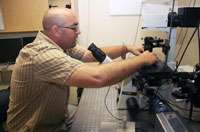Scientist peers into cell division mechanics

A researcher at the University of Wyoming is peeling away the mysteries enshrouding a cellular process occurring billions of times a day in a body, is absolutely precious to life and traces back through the murky eons of time to our origins - a living Xerox copier set on automatic.
It's cell division, studied by every high school biology student, but Jay Gatlin, an assistant professor in the Department of Molecular Biology in the College of Agriculture and Natural Resources, and his laboratory team take such study exponentially higher.
For example, he measures the amount of force (measured in picoNewtons) exerted to pull chromosomes toward opposite ends of the mitotic spindle, the football-shaped form with two distinct poles that takes shape during cell division. One Newton roughly corresponds to the weight of a cup of tea. If a Newton is divided by 1 million, the result is a microNewton. If a microNewton is divided by 1 million, the result is 1 picoNewton.
Gatlin says cell division is very much a mechanical process.
"This structure (spindle) is assembled by the cell, and its function is to physically pull duplicated chromosomes apart. The spindle has to pull apart chromosomes attached through linkages. During mitosis, all the chromosomes align and a checkpoint becomes inactivated and - Bam! - the cell divides," he says. "This movement requires the generation of force. We know very little about what sort of forces this thing is capable of generating. By understanding the forces, the dynamics, we can learn a lot about the structure itself, how it is assembled, how it works."
Gatlin wants to improve the resolution of measurements by developing new microscopy-based approaches.
"There are forces that want to bring the two poles together and forces that want to keep them apart," he says. "I'm interested in measuring the magnitude of the forces in hopes that, by understanding or characterizing these forces, we will begin to have a better understanding of spindle function in general, how it pulls the chromosomes apart and what it is capable of doing."
Provided by University of Wyoming

















